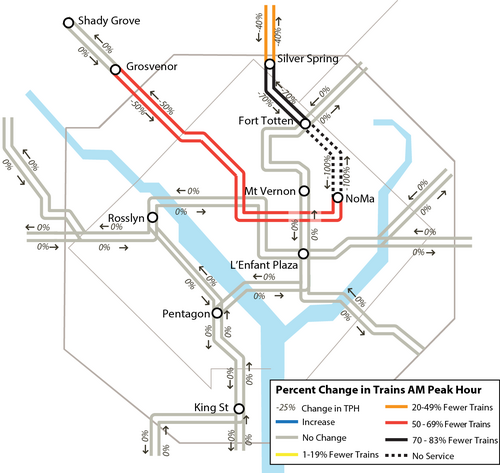The shutdown is coming! The shutdown is coming! (On the Red Line)
SafeTrack’s biggest shutdown is just about here: for 25 days, from October 29th through November 22nd, Red Line trains won’t run between the NoMa-Gallaudet and Fort Totten stations. If you use the Red Line at all, regardless of where in the system, you can expect fewer trains, delays on the ones that come, and lots of crowding.

If you use the Red Line on the parts that are staying open, this might be your life for the next few weeks. Photo by ep_jhu on Flickr.
Be prepared for significant service impacts
This is the tenth of SafeTrack’s “surges,” which just means it’s the tenth area where Metro is doing a deep dive on maintenence work. Trains coming from Grosvenor or Shady Grove will not (!) go all the way to Silver Spring or Glenmont— they’ll all turn back around at NoMa. Similarly, trains from Glenmont and Silver Spring will turn around at Fort Totten. Anybody needing to go farther than those two points will need to find a bus, or transfer to the Green/Yellow Lines at Gallery Place or Fort Totten to bridge the gap.
Since NoMa and Fort Totten weren’t designed to be terminal stations which might allow trains to turn around quickly, and accounting for the various speed restrictions along the Red Line, trains will only run every six minutes between Shady Grove and NoMa, and every 10 minutes from Glenmont to Fort Totten.
If you usually rely on Metro to travel in these areas, here are your options
Metro’s SafeTrack advisory page lists a number of Metrobus, Ride On, MARC, bike, and carpool routes and options that might be able to help to get around the 25-day shutdown, or provide alternate routes when traffic or a breakdown inevitably snarls your commute during the surge.
Metro’s bus shuttles will operate between NoMa, Rhode Island Avenue, Brookland, and Fort Totten stations from system opening to closing. Ride On is offering its own free shuttles between the Silver Spring, Takoma, and Fort Totten stations, and Montgomery County will be giving out some free round-trip MARC tickets through Friday the 28th.
Other buses available for passengers to get around the shutdown are the 80 which connects Fort Totten and Brookland to Union Station, Gallery Place, and Metro Center, the S9 directly from Silver Spring to to Columbia Heights and McPherson Square, and the P9 P6 connecting Anacostia to Metro Center up to Rhode Island Avenue.
Last but certainly not least, Montgomery County has an interactive map showing park-and-ride lots, and there are also bike maps for how to traverse the area on bike along with the SafeTrack-specific detour signs
What work will Metro do during the shutdown? It’s not saying so we have to guess.
Unfortunately, there’s no information posted on Metro’s website about what specific work is being performed. Communication about the specific work being done is one of the big sticking points between Metro and passengers, and it has been since SafeTrack started and well before even for Metro employees.
It’d be nice for customers to know what work is being done to repair the tracks so they can see what kind of tangible benefits the present headaches might yield; without that kind of information, it’s hard to continue to support the system.
In the absence of a planned work schedule, I can look at previous surges and take my best couple guesses at what Metro will be doing during the 25 days.
- Likely, there again will be four main sections of work that they will try to get done: track, structures, automatic train control, and traction power.
- Track work being done between NoMa and Fort Totten will likely again include major rail tie replacements numbering in the hundreds or thousands. Depending on the status of the ballast — the gravel that the rail ties rest on — crews may need to place more under the track, or replace some of what is already there if it’s not in good condition.
- As with the other surges, power cables will be checked and replaced, the intrusion detection warning system will be refurbished where needed, emergency trip station lights will be repaired, and any signals in the area should be converted to LED lights if they aren’t already.
But apart from these generic work summaries, there’s no real way to know exactly what’s scheduled to get done during this surge. Even if there were, though, the agency itself still doesn’t have metrics to determine if SafeTrack was a “success.”
Hopefully, at very least, the speed restriction near Rhode Island Ave which was put in place to “minimize structural deterioration” is addressed, and trains can resume going normal speeds through the station without fear of concrete falling from the ceiling.

